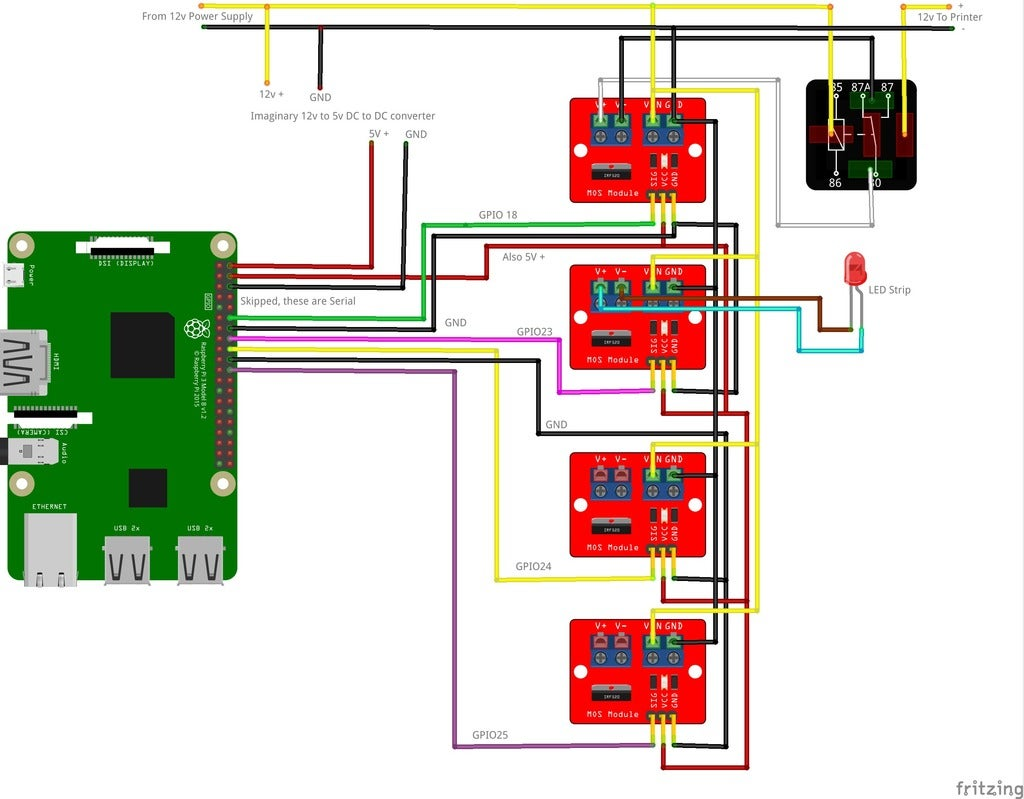
Octoprint and GPIO Control Tutorial!
cults3d
#How to setup Octoprint with GPIO control! Download for copies of the pictures and a text file with the code in it as well as a bonus 40mm fan grill! See the RAMPS tutorial here! (https://www.thingiverse.com/thing:2784817) See the Marlin Firmware tutorial here! (https://www.thingiverse.com/thing:2783450) This is all about how to use a Raspberry Pi 3 or 3B+ as an Octoprint server on your 3D printer! #Bill Of Materials Let's start with what you'll need. Raspbery Pi 3** or better Octropi image for the Raspberry Pi Some MOSFET modules to control lights and power relay I recommend a 64GB SD card for use with timelapse Raspberry Pi Camera, Wide angle helps here! Long cable for camera A 5v power supply, you can use a separate one or use a voltage converter, or a PC power supply, up to you! 12v to 5v converter 5v power supply from wall I use LED strip lights Main power relay for printer I use that because it's reliable and easy to replace if needed. A short USB Cable A case for the Raspberry Pi with room for wires and cooling (https://www.thingiverse.com/thing:3183658) **A note on power of the computer! Octoprint takes some grunt to run. It's live sending commands to the printer and especially with camera doing time lapse a Raspberry Pi 3 or something similar or better is highly recommended. I use Raspberry Pi 3B+ and Orange Pi Plus 2E with 2gb RAM. You can search and find ready to use disk images for many single board computers and instructions to setup Octoprint on Debian. #How to! First thing first, burn Octopi on your SD card! You can use a program like Win32 Disk Imager to do this or your favorite disk writer! Once that is done keep the card in your PC. Browse to it and you will see a file named "octopi-wpa-supplicant.txt" on there. Open and add your WiFi details as follows: network={ ssid="Your Wifi SSID" psk="supersecretwifipassword" } Be sure to set your WiFi country in that file as well! Save this file and safely eject the SD card before you remove it to install in the Raspberry Pi. #Wiring! This is not as intimidating as it looks I promise! Let's start with that 5v supply for the Pi. Since in this guide we will be cutting the printer power you need to install the heavy duty 12v relay between the printer's main positive power feed and the power supply. #Note! The USB cord wil;l power most boards, including RAMPS! You may need to peel back some of the outer insulation on the USB cord and snip the Red wire inside to prevent the USB port from keeping the board on when you use your relay control to turn it off. Before the relay you need to tap 12v to power the voltage converter if you are using that to power the Raspberry Pi. Let's look at the basic schematic: Here you can see the MOSFET boards, the Pi, Voltage converter and main power relay hooked up as you would on the printer. #The pins on the Raspberry Pi as numbered based on the GPIO number which is not the pin number! Please pay close attention to the positions as this will be very important later. On the Rasberry Pi you can use Dupont connectors or solder carefully right to the pins. Either work! There's the pinout on the Raspberry Pi. Per the drawing we will be using GPIO 18, 23, 24, and 25. Each to control a channel. Most of you would really only need two, one for a light and one for power. In that case just use 18 and 23. Assemble the Raspberry pi, wires, camera cable and SD card into the case and mount on your printer somewhere out of the way. On mine I put it high on the same side as the main board. Once the Pi is mounted mount your MOSFETS and Relay nearby. This is just to simplify wiring. Connect the wires from the 5V, GND, and GPIO as shown in the diagram above, Also use this to connect the Relay in to the main 12v+ wire of the rest of the printer so it can be shut down from the Octoprint interface. Wire carefully, use good connections with solder and heat shrink. Check and double check everything and don' ever work on a machine that's powered on! Once you have the wiring situation done we can move on to setting up the pi! #Setup and config With the Pi plugged in and on find it's IP on your network and browse to that or try http://octopi.local in your browser. You'll be greeted with the Octoprint setup wizard! Click through and fill in all the information needed. Next we setup the user and access control. This is important and you want to turn it on! Next configure the connectivity check, I turn this on too. Then we configure the blacklist processing, again this should be on. Next is the printer profile. This is where you setup how Octoprint interacts with your machine. It is important to set this accurately for your printer, I am using the Anet A8 here since I have two of those. Start with the name of your machine and type: Then on the next tab set your build volume up Now on to the Axes, these I just leave as is in my case. The last printer page is the extruder, dual in this example: 